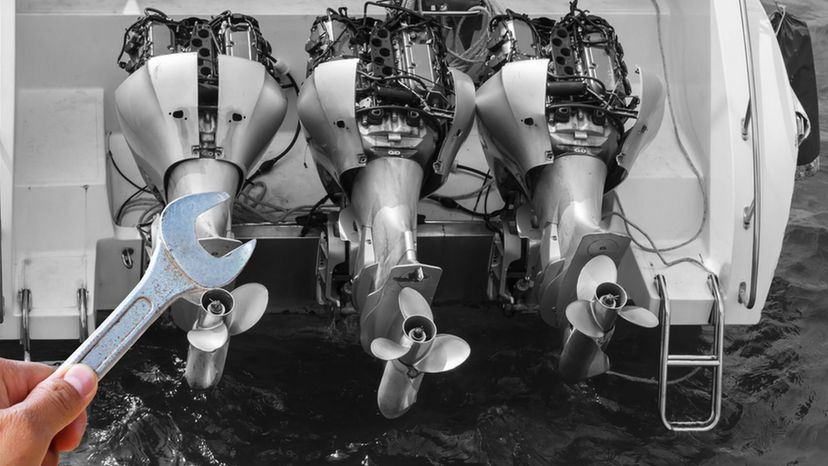
About This Quiz
When you're stranded in the middle of a lake and you can't get the engine to work, you'll wish that you had taken this quiz. No bones about it, if you're driving (or piloting?) a boat, be sure that you know how to use the engine. Ahoy, matey!Boat engines are otherwise known as outboard motors. They are the number-one propulsion systems for boats.
All of these components go into a boat motor. Boat motors have either a propeller or a jet drive.
The boat motor is affixed to the transom. The transom is the flat surface forming the stern of a vessel.
Advertisement
Outboards, as well as providing propulsion, also provide steering control. They pivot over their mountings and control the direction of thrust.
The skeg is the lowest part of the outboard motor. It can act as a rudder when the boat engine is not running.
Outboard motors can most definitely be removed. This is unlike inboard motors, which cannot easily be removed from the vessel.
Advertisement
When you tilt the outboard motor, you can prevent it from hitting bottom. The tilting can either be done manually or electronically.
Every outboard motor is equipped with manual piston release that allow you to drop the motor down to its lowest setting. This is good to know when you're stranded in the middle of a lake.
Large outboards are almost always linked to controls at the helm and bolted to the transom. They can also be linked to a bracket bolted to the transom.
Advertisement
Large outboards can range from two to six cylinders. Consider the weight of the boat when selecting a motor.
Yes, are outboards can have V engines. They can even have V6 or V8 engines rated up to 557 hp. These work for boats 37 feet or longer.
Portable outboards can have up to 20 horsepower, and they're easy to take on and off the boat.
Advertisement
Portable outboards are affixed to the boat via clamps. That's why they're so easy to move from boat to boat.
Small outboards are often started manually, but some are electric start. They have throttle and gearshift controls mounted on the body of the motor.
The smallest outboards weigh about 26 pounds. They have integral fuel tanks and are best used for a small dinghy.
Advertisement
Trolling is a method of fishing where two or more lines are drawn through the water. Small outboards are perfect for trolling.
A jon boat is a small, flat-bottomed boat with one, two or three benches. This kind of boat uses a small outboard.
Electric outboards are easy to use, quiet and efficient. That's why they're so great for fishing. They're otherwise known as trolling motors.
Advertisement
Pump-jet propulsion is the ideal choice when you're going to be in shallow waters. This is always an option with an outboard motor.
Propane is definitely an option for some outboard motors. Not only that, but they're cheaper to maintain, have lower emissions, and there's no need to choke them once the system is pressurized.
The first outboard was designed in 1870 by Gustave Trouvé. It was patented in 1880. American Motors Co produced more in 1896.
Advertisement
Waterman outboard engines were the first to be available for sale. These were developed by Cameron Waterman, a Yale engineering student.
The first mass-produced outboards were called Porto-Motors. 25,000 were sold by 1914.
The majority of outboards used to be two-stroke powerheads. These were fitted with a carburetor, giving the design simplicity, low weight and reliability.
Advertisement
The four-stroke outboard was indeed modeled after a car engine. The 4-cylinder Crosley engine was the inspiration. This outboard was called the Bearcat.
Honda Motor Co. offered the four-stroke powerhead in 1964. Yamaha finally caught up to them in 1984.
It was ultimately emissions regulations that led to the proliferation of the four-stroke engine. Take for instance regulations by CARB, California Air Resources Board.
Advertisement
In 2012, the first propane-powered outboards were produced. They were brought to the market by Lehr.
Honestly, the most important reason for picking the right motor for your boat is overpowering. If you get a motor that is too strong, it can lead to the transom accelerating past the rest of the vessel.
The Coast Guard Rating Plate is your resource for finding out what is the maximum recommended horsepower for your hull. Be sure to check it out before buying an outboard.
Advertisement
Your outboard motor should have at least 75% of the maximum performance in order to work well. Anything below 75% will result in poor performance.
Large vessels, like cruise ships, generally use a diesel-powered engine. Some use gas turbine engines or a combination of the two.
Outboard motor shafts are designed to fit either 15, 20, 25 or 30-inch transoms. Respectively, these are S, L, XL, and XXL. When the shaft is too long, it will create drag.
Advertisement
When the shaft length of your outboard is too short, cavitation occurs. The propeller churns air or engine exhaust, which eventually damages the propeller.